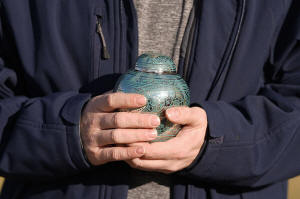Their remains were found decades ago. A new push could identify all of a
serial killer's victims
 Send a link to a friend
Send a link to a friend
 [January 07, 2025]
By RICK CALLAHAN [January 07, 2025]
By RICK CALLAHAN
WESTFIELD, Ind. (AP) — Decades after investigators unearthed thousands
of human bones and bone fragments on a suspected Indiana serial killer’s
property, a renewed quest is playing out in laboratories to solve a
long-running mystery: Who were they?
A new team working to identify the unknown dead says the key to their
success will be getting relatives of men who vanished between the
mid-1980s and the mid-1990s to provide samples of their own DNA.
Those samples can then be screened against DNA profiles scientists are
extracting from the remains, which were found starting in 1996 on
Herbert Baumeister’s sprawling suburban Indianapolis property.
The original investigators believed that at least 25 people were buried
at Baumeister’s 18-acre (7.3-hectare) Fox Hollow Farm estate in
Westfield, based on evidence that included 10,000 bones and bone
fragments, as well as handcuffs and shotgun shells.
Baumeister, a 49-year-old thrift store owner and married father of
three, killed himself in Canada in July 1996 before police could
question him, taking with him many secrets, including the names of his
presumed victims.
Investigators believed that while his family was away on trips,
Baumeister, who frequented gay bars in Indianapolis, lured men to his
home, where he killed and buried them.

By the late 1990s, authorities had identified eight men using dental
records and available DNA technologies. But then those efforts stopped,
although the remains of at least 17 people may have still been
unidentified.
Hamilton County Coroner Jeff Jellison said the renewed identification
effort revealed that county officials at the time decided not to fund
additional DNA testing, which “essentially halted further efforts to
identify the victims and placed the cost of a homicide investigation on
family members of missing people.”
“I can’t speak for those investigators, but it was just game over,”
Jellison said.
An unfinished job
As decades slipped by, the bones and fragments sat in boxes at the
University of Indianapolis' Human Identification Center, whose staff
helped excavate the remains.
That changed after Eric Pranger sent Jellison a Facebook message in late
2022. The Indianapolis man's family had long believed his older cousin,
Allen Livingston, was among Baumeister’s victims.
Livingston was 27 when he vanished in August 1993 after getting into
someone else’s car in downtown Indianapolis. After hearing about
Baumeister three years later, his mother, Sharon Livingston, and other
relatives began suspecting that Allen, who was bisexual, was among the
dead.
Jellison was about to take office when Pranger asked if he could help
get some answers for his aunt, who had serious health problems.
“How do you say to no to that? That’s our job as coroners by statute, to
identify the deceased,” Jellison said.
In late 2022, police took DNA samples from Sharon Livingston and one of
her daughters. Jellison began working with a team that includes the
Indiana State Police, the FBI, the Human Identification Center, local
law enforcement and a private company that specializes in forensic
genetic genealogy.

A family finds some closure
Staff at the Human Identification Center, where the remains are stored
in a temperature- and humidity-controlled space, selected some of the
most promising bones for DNA analysis.
At the Indiana State Police Laboratory, scientists cut out sections of
bone, froze them with liquid nitrogen and pulverized them into a fine
powder. They then used heat and chemicals to break open bone cells in
the first step toward extracting a full DNA profile.
Nearly a year after hearing from Pranger, Jellison announced in October
2023 that a ninth Baumeister victim had been identified: Allen
Livingston.
Sharon Livingston finally received some form of closure. She died in
November 2024.
“It made me happy to be able to do this for my aunt," Pranger, 34, said.
“I’m the one who got the ball rolling to bring her son home after 30
years and I felt privileged."
[to top of second column]
|

Eric Pranger holds an Urn that contains the ashes of Allen
Livingston, Saturday, Dec. 21, 2024, in Westfield, Ind. (AP Photo/Darron
Cummings)

“After Allen was identified I was so excited and then after the fact
I asked myself, `Now what? I got answers, but what about all the
other families?’” Pranger added.
The other victims
Jellison said about 40 DNA samples have been submitted by people who
believe a missing male relative may have been killed by Baumeister.
He said those are entered into the FBI’s Combined DNA Index System,
or CODIS, but are used solely for identifying missing people.
The coroner and his partners hope to get more DNA samples from
relatives of men from across the U.S. who vanished between the
mid-1980s and mid-1990s. They noted the men may have been traveling
and stopped in Indianapolis to visit friends or sample its
nightlife.
To date, scientists have extracted eight unique DNA profiles — all
male — from more than 70 of the 100 bones that were sent to the
Indiana State Police Laboratory by Dr. Krista Latham, the Human
Identification Center's director.
One matched DNA samples provided by Livingston’s mother and sister.
Four matched four of the eight men first identified in the 1990s:
Jeffrey Jones, Manuel Resendez, Johnny Bayer and Richard Hamilton.
The three other DNA profiles remain unidentified and two are still
undergoing testing. Those three have boosted Baumeister’s presumed
victims to 12.
What's next?
Jellison and his partners say their identification effort could take
several more years to complete.
Most of the bones were crushed and burned, reducing their potential
to yield usable DNA. Latham, a professor of biology and
anthropology, said bone fragments deemed in poor shape are being
held back from the destructive testing process in hope that future
DNA technologies can unlock their secrets.
She noted some of the men may have been estranged from relatives or
ostracized because of their sexuality. No one may have noticed when
they vanished.

“These are individuals who were marginalized in life. And we just
need to make sure that that’s not continuing in death as well,”
Latham said.
For the ongoing work, Jellison has obtained DNA reference samples
from relatives of seven of the eight men originally identified in
the 1990s. The eighth man, Steven Hale, was adopted and efforts to
locate biological relatives have thus far failed, the coroner said.
Relatives of missing men who want to provide family DNA reference
samples for the effort to identify remains can contact the Indiana
State Police missing persons hotline at 833-466-2653 or the Hamilton
County Coroner’s Office at 317-770-4415.
Honoring the victims
As remains are identified, piece by piece, families can opt to have
them cremated and interred at a memorial dedicated in August in
Westfield. It includes a plaque with the names of the nine
identified victims, with room for more names.
Linda Znachko, whose nonprofit Indianapolis-based ministry He Knows
Your Name, paid for the monument, said at the memorial's dedication
that the identification campaign "will bring honor to those who lost
their lives at the Fox Hollow tragedy.” Remains belonging to
Livingston and Jeffrey Jones were added to the memorial's ossuary
and white doves were released during the dedication.
Livingston’s younger sister, Shannon Doughty, attended with several
relatives, including Pranger. She said it was a relief finally
knowing what happened to her brother, despite his tragic end.
“At least you know,” said Doughty, 46. “The fear of the unknown is
the worst right? So just knowing, it’s a multitude of emotions. You
wanted to know but you didn’t want to know. But you needed to know.”
All contents © copyright 2024 Associated Press. All rights reserved
 |